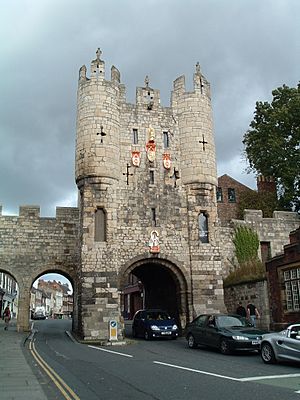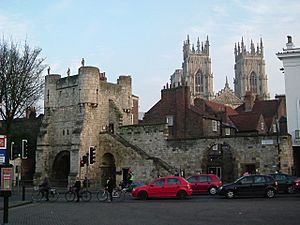Siege of York facts for kids
Quick facts for kids Siege of York |
|||||||
|---|---|---|---|---|---|---|---|
| Part of First English Civil War | |||||||
 Micklegate Bar and part of the City walls. In 1644, there was a barbican in front of the gate |
|||||||
|
|||||||
| Belligerents | |||||||
| Commanders and leaders | |||||||
| Strength | |||||||
| 800 horse 5,000-foot |
14,000 + up to 80 guns |
||||||
| Casualties and losses | |||||||
| 1,000 killed and wounded 1,000 paroled |
Unknown | ||||||
The Siege of York in 1644 was a long fight for the city of York during the First English Civil War. It involved armies from Scotland (called Covenanters) and English Parliamentarian forces. They fought against the Royalist army, led by the Marquess of Newcastle.
The siege started on April 22 and lasted until July 1. On that day, Prince Rupert of the Rhine arrived and helped the Royalists in York. However, Rupert and Newcastle's armies were defeated the very next day at the important Battle of Marston Moor. After this big loss, the siege of York began again. The city finally gave up on July 16, under fair conditions.
Contents
The English Civil War and York
York's Importance in the 1600s
In the 17th century, York was a very important city. Many people called it the "capital of the north" or even the "second city in England." It was a major center for trade and was home to the Archbishop of York, which gave it great respect.
When the Civil War began in 1642, Royalist supporters in Yorkshire were briefly trapped in York. But the Earl of Newcastle (who later became a marquess) came to their rescue with his army from the northern parts of England.
Early Battles and Royalist Victories
The next year, Newcastle's Royalist army defeated the Parliamentarian army from the north. This army was led by Lord Fairfax and his son Sir Thomas Fairfax. The battle was called the Battle of Adwalton Moor. After their defeat, the Parliamentarian soldiers were forced into the city of Hull.
The Royalists then tried to capture Hull, but they couldn't stop Parliament from sending supplies to the city by sea. Newcastle also sent some of his troops south into Lincolnshire. However, these troops were defeated in battles at Gainsborough and Winceby. These defeats were caused by Parliamentarian cavalry led by Oliver Cromwell and Sir Thomas Fairfax.
The 1644 Campaign Begins
In late 1643, Parliament made an agreement with Scotland called the Solemn League and Covenant. Because of this, a Scottish army, led by the Earl of Leven, marched into Northumberland on January 19, 1644.
The Marquess of Newcastle took most of his army north to face this new threat. He left John Belasyse in charge of York with about 1,500 cavalry and 1,800 foot soldiers.
Meanwhile, Sir Thomas Fairfax's cavalry, who had been fighting in Cheshire, started moving back towards Yorkshire. To stop them from joining Lord Fairfax's army in Hull, Belasyse took control of Selby. Selby was a town located between the two Parliamentarian forces.
On April 11, Thomas Fairfax and Parliamentarian foot soldiers, led by Sir John Meldrum, attacked and captured Selby. They also captured Belasyse and most of his army.
When Newcastle heard this news, he realized York was in danger. He quickly rushed back to the city, arriving on April 19. The Scottish army followed him and joined up with the Fairfaxes. Together, they reached York and began the siege on April 22.
The Siege: April to June
Newcastle sent most of his cavalry out of York to join other Royalist armies. Even though they were chased, they managed to escape. These cavalry troops, led by Newcastle's Lieutenant General of Horse, Lord Goring, moved south and then crossed the Pennine mountains into Lancashire.
About 800 cavalry and 5,000 foot soldiers stayed in York. They were under the command of Newcastle and his Lieutenant General of Foot, Lord Eythin.
York is located where the River Ouse and the smaller River Foss meet. At that time, York had the only bridges over the Ouse for many miles. This made it hard for the attacking armies to completely surround the city.
The Scottish army set up their positions west of York, while the Fairfaxes were to the east. The River Foss had been blocked near the Ouse a long time ago, creating a large lake that protected the city's northeast side.
The Parliamentarians built a bridge of boats over the Ouse at Acaster Malbis, a few miles south of York. This allowed their two armies to communicate with each other. The area north of the city, between the Ouse and Foss, was left open. This meant the Royalist soldiers inside York could send messages and even get some food through this unguarded area.
Most of the action during this time came from the Royalist soldiers inside York. They made a quick attack to burn down houses in the nearby village of Acomb. This was to stop the attackers from using the houses for shelter. The Royalists also carried out other small raids.
The main concern for the attacking armies was keeping their supply lines open to Hull. This is where they received their supplies, especially weapons and ammunition.
The Siege: June Attacks
The Parliamentarian army from the Eastern Association, led by the Earl of Manchester, joined the siege of York on June 3. They took control of the northern area between the Ouse and Foss, which had been unguarded until then. Another bridge of boats was built across the Ouse at Poppleton. This helped all the attacking armies communicate better. With the northern area secured, many Parliamentarian cavalry could be sent to clear the area around York. Several small Royalist outposts nearby, like Crayke Castle, were captured.
The attacking armies now began serious operations. York's main defenses were its medieval city walls. There were also several small forts, called "sconces," built outside the walls. Each sconce had a small group of soldiers and a few cannons.
The Scottish army attacked two of these sconces on the western side on June 6. However, they failed to capture another sconce at The Mount, which was near Micklegate Bar. This was because Royalist soldiers rushed out from the gate to help defend it. After this, the Royalists gave up their remaining outer forts.
The attackers then formally asked the Royalist soldiers in York to surrender. Newcastle started talking about a surrender agreement, but he was likely just trying to gain time. Both sides seemed to be acting dishonestly during these talks, which lasted from June 8 to June 15. On June 10, Royalist cavalry tried to escape the city but were forced back into York. Meanwhile, the attackers had been setting up cannons and digging tunnels (mines) under the city's defenses.
Failed Attack on the Walls
The attackers focused their efforts on two other areas. To attack Walmgate Bar, they placed cannons on a nearby hill called Lamel Hill. They also dug a mine under the Walmgate Bar's outer defense. The cannon fire damaged the bar, and you can still see the marks today. It also destroyed St Lawrence Parish Church and other buildings. A Royalist soldier who had left the Parliamentarian side warned them about the mine. The Royalists then dug a counter-mine and flooded the Parliamentarian tunnel.

At Saint Mary's Tower, which was outside Bootham Bar on the northwest corner of the walls of the old St Mary's Abbey, Manchester's soldiers dug another mine. On June 16, this mine exploded and destroyed the tower. A group of foot soldiers rushed into the gap in the wall. However, no more soldiers were sent to support them. Some Royalist soldiers came out from a hidden gate by the river and recaptured the breach from behind, trapping the attackers. The Parliamentarians lost 300 soldiers. Even though there was constant fighting at the breach, the Parliamentarians did not try another attack.
The Siege is Lifted
Around this time, two armies were getting close to York. Prince Rupert of the Rhine was gathering a large Royalist army in Lancashire to help York. Although more Parliamentarian soldiers were coming from the Midlands, they couldn't arrive in time to stop Rupert. On June 28, the attackers learned that Rupert was preparing for battle. On June 30, they temporarily stopped the siege and moved to Marston Moor to face him.
At first, the Royalist soldiers inside York didn't know the attackers had left. But guards later reported that the Scottish and Parliamentarian soldiers were no longer making noise or shouting insults as they usually did. Patrols were sent out from the city and found that the attackers had indeed left. There was a small fight between these patrols and a Parliamentarian group that was staying behind at Fulford.
Once everyone in York knew the siege was over, Newcastle's soldiers rushed out from their defenses. They took many valuable items, including cannons, ammunition, and 4,000 pairs of shoes, from the abandoned siege lines and camps.
Meanwhile, Rupert had cleverly gone around the Scottish and Parliamentarian armies. He reached York from the north. Rupert said he had orders from the King to defeat the Scottish and Parliamentarian armies in battle before returning south. He strongly demanded that Newcastle send his soldiers to join Rupert's army for an immediate battle. This was difficult because Newcastle's troops had not been paid for some time. They were refusing to fight and demanding their pay or to be allowed to leave.
Eventually, after Rupert and Newcastle spoke to them, 3,000 soldiers (plus 100 "gentleman volunteers" on horseback) rejoined their units. They marched out around midday on July 2. They left 1,000 soldiers to defend York.
That evening, the Royalist army was defeated at the Battle of Marston Moor. Soldiers who had run away or were injured made their way back to York. Sir Henry Slingsby later wrote that it was very confusing when they arrived in York. Only people from the town were allowed in, so the street was filled with wounded and injured people, making a sad noise.
The Siege Ends
Even though the Royalists still had other troops and forts in the north, Rupert felt he was needed with the King's main army in the south of England. So, on July 4, he led the soldiers he had gathered (5,000 cavalry and a few hundred foot soldiers) out through Monk Bar on the eastern side of the city. Newcastle believed the situation was hopeless. He sailed from Scarborough with his senior officers to live in other countries.
Sir Thomas Glemham was left as the governor of York. The Scottish and Parliamentarian armies, now stronger with more soldiers, started the siege again on July 5. Glemham only had 1,000 soldiers. There was no longer any hope of help. Glemham could only try to get good terms for surrender.
On July 16, his soldiers marched out of the city with their weapons and flags. They headed towards Richmond and Carlisle. Most of them left the army within a few days.
Lord Fairfax was made the new Governor of York by Parliament. He earned the city's thanks because he stopped some religious extremists in the winning armies from damaging the many churches in York, including York Minster.
|
See also

